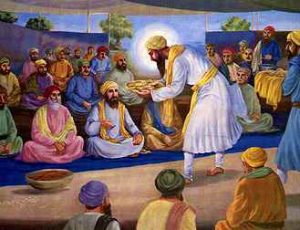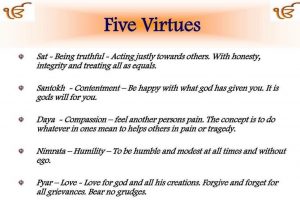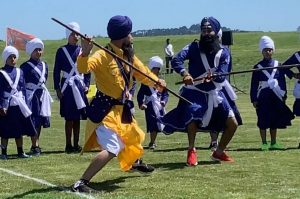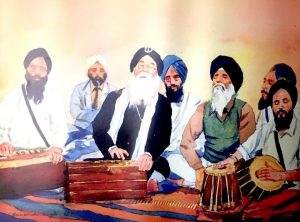3 Core Values – Sikh’s Way of Life
- Naam Japo- Chanting God’s name – To do prayers
- Kirat Karo- Truthful Living – To earn an honest living
- Vand Chako- Being Generous – To share 10% of income with others

What is Dasvand?
“ਘਾਲਿ ਖਾਇ ਕਿਛੁ ਹਥਹੁ ਦੇਇ ॥ ਨਾਨਕ ਰਾਹੁ ਪਛਾਣਹਿ ਸੇਇ ॥੧॥” -(SGGS p.1245)
One who works for what he eats, and gives some of what he has – O Nanak, he knows the Path.
Dasvand is the one-tenth part of the earnings that one should contribute to charity or giving. It is the obligation of the Sikh religion to contribute 10% of their earnings in giving back to the community in the form of selfless service to those who are in much need, which is highly valued in Sikhism. This concept was started by Guru Nanak Dev ji, the first Guru of the Sikh religion by introducing the concept of Langar (free food) for the Sangat (common people – refers as the Holy assembly)
Translation: Dasvand is a holy ritual through which the four human envies – poverty, futility, health impairment, and illiterate, can be demolished. This can bring peace and happiness to the world.

Value of Selfless Service (Sewa)
“He alone performs Guru’s Seva whom the Lord Himself causes so to perform.”
ਗੁਰ ਕੀ ਸੇਵਾ ਸੋ ਕਰੇ ਜਿਸੁ ਆਪਿ ਕਰਾਏ ॥“
Selfless service is performed without any expectation of result or an award for performing it. Sewa means ‘service’, referring to the selfless efforts for the welfare of all. It is a volunteering service to serve humanity without any personal gain and to promote the welfare of fellow human beings. This brings peace, happiness to those struggling with mental, and physical issues.
Guru Nanak Dev Ji started the Selfless service by providing free Langar irrespective of caste, color, or creed based on equality.
Guru Nanak Dev says,
“Do Seva and service in this world and find a seat in the court of God”
ਵਿਚਿ ਦੁਨੀਆ ਸੇਵ ਕਮਾਈਐ ॥
ਤਾ ਦਰਗਹ ਬੈਸਣੁ ਪਾਈਐ ॥
( Sri Rag M-1, 26 )
It is the duty of The Sikh to serve the needy, sick, and poor. He should not take pride to have served the less fortunate as their benefactor and protector, rather feel it as a responsibility to serve humanity, regarding all humans as one and equal.

Sikh’s Headgear – Turban
Among Sikhs, Turban is their headgear, an article of faith that represents equality, honor, self-respect, courage, and spirituality. The Sikh men and sometimes, women wear turbans to cover their uncut hair. The turban is considered the unique identity of a Sikh and it is a part of a Sikh’s uniform. It is a gift to us from our tenth Guru, Guru Gobind Singh Ji.
“ਖ਼ਾਲਸਾ ਮੇਰੋ ਰੂਪ ਹੈ ਖ਼ਾਸ ॥ ਖ਼ਾਲਸੇ ਮਹਿ ਹੌ ਕਰੌ ਨਿਵਾਸ ॥
“Khalsa is a true picture of mine. I live in Khalsa.”

The Five Sikh Virtues
- Sat – Be Truthful, act justly with others with honesty, integrity, and regard all as equal and one.The Lord’s humble servants are True — they practice Truth, and reflect upon the Word of the Guru’s Shabad. The True Lord God unites them with Himself, and they keep the True Lord enshrined in their hearts. O Nanak, through the Name, I have obtained salvation and understanding; this alone is my wealth. – Guru Granth Sahib Ji, ang 600
- Santokh- Contentment- Learn to be happy with what God has given to us. Everything happens in our life’s as per God’s will.Practice truth, contentment and kindness; this is the most excellent way of life. One who is so blessed by the Formless Lord God renounces selfishness, and becomes the dust of all.
— Guru Granth Sahib Ji, ang 51
- Daya – Compassion- To consider anyone’s sorrow/pain as your own and try to help them as much as you could.Be kind to all beings-this is more meritorious than bathing at the sixty-eight sacred shrines of pilgrimage and the giving of charity.
— Guru Granth Sahib Ji, ang 136
- Nimrata- Humility- To be humble and kind at all times.ਮਿਠਤੁ ਨੀਵੀ ਨਾਨਕਾ ਗੁਣ ਚੰਗਿਆਈਆ ਤਤੁ ॥ Humility, Nanak Says is the essence, the very root of all virtues
— Guru Granth Sahib Ji, ang 470
- Pyar – To feel fulfilled with the love of God, no grudges for anyone.Let the Fear of God be your feet, and let His Love be your hands; let His Understanding be your eyes.
— Guru Granth Sahib Ji,ang 139
Source: https://en.wikipedia.org/wiki/Five_Virtues

Gatka – The Sikh Martial Art
Gatka is the traditional martial art of the Sikhs. It is based on the basic principle of unification of the mind, body, and spirit in a rhythm of life to train a saint- soldier to be able to defend himself or herself. When learning the art, you go from bare-handed combat to using various shastras (weapons) such as kirpans, sticks, lathis, marotis, nun chucks, axes, and a lot more.
Source: https://www.sikhiwiki.org/index.php/Gatka

Importance of Kirtan
Kirtan is also one of the important aspects of Sikhism that refers to the singing of the Sacred Hymns from the Guru Granth Sahib Ji accompanied by music. The Sikhs place huge value on this type of singing and a Sikh is expected to listen to and/or sing Guru-Kirtan as frequently as possible. It is the spiritual way of remembering the God and understanding the God’s teachings.
ਕਲਜੁਗ ਮਹਿ ਕੀਰਤਨੁ ਪਰਧਾਨਾ ॥ ਗੁਰਮੁਖਿ ਜਪੀਐ ਲਾਇ ਧਿਆਨਾ ॥
In this Dark Age of Kali Yuga, the Kirtan of the Lord’s Praises are most sublime and exalted.
Become Gurmukh, chant and focus your meditation. – Guru Granth Sahib Ji, ang 1075

